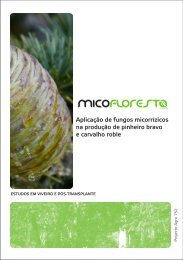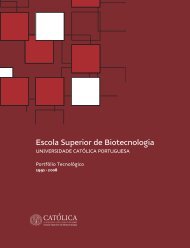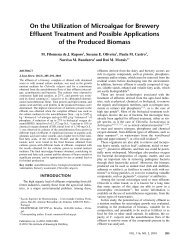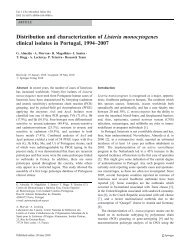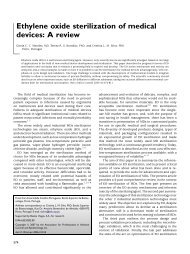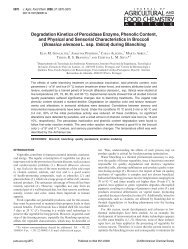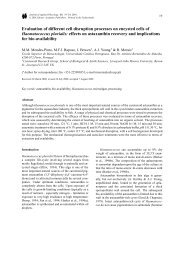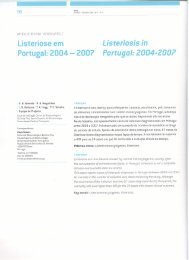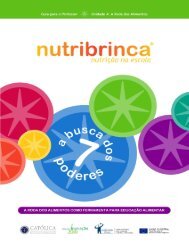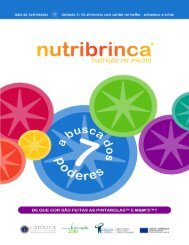Agenda - Escola Superior de Biotecnologia - Universidade Católica ...
Agenda - Escola Superior de Biotecnologia - Universidade Católica ...
Agenda - Escola Superior de Biotecnologia - Universidade Católica ...
Create successful ePaper yourself
Turn your PDF publications into a flip-book with our unique Google optimized e-Paper software.
Feeding the World – International Day of Cooperation<br />
Webinar<br />
5 th July / 2013<br />
Jointly organized by: &<br />
AGENDA:<br />
15:00 -‐ Welcome Note – Prof. Cristina L.M. Silva, <strong>Escola</strong> <strong>Superior</strong> <strong>de</strong> <strong>Biotecnologia</strong> – Universida<strong>de</strong><br />
<strong>Católica</strong> Portuguesa, Portugal<br />
15:10 -‐ “Criollitos” a salty puff pastry product – Prof. Pablo Daniel Ribotta & Ana Elizabeth <strong>de</strong> la Horra,<br />
Facultad <strong>de</strong> Ciencias Exactas, Físicas y Naturales – Universidad Nacional <strong>de</strong> Córdoba, Argentina<br />
15:15 -‐ Pinhão, a typical food from South of Brazil – Prof. Estela <strong>de</strong> Oliveira Nunes, Santa Catarina West<br />
University (Unoesc), Brazil<br />
15:20 -‐ Technological advances for the functional use of Brazilian passiflora – Prof. Ana Maria Costa,<br />
Embrapa Cerrados Brasília, Brazil<br />
15:25 -‐ Green Coconut Pulp as Food Ingredient – Prof. Antonia Miwa Iguti, Maua Institute of<br />
Technology Sao Caetano do Sul, Brazil<br />
15:30 -‐ Optimization of the drying process of mortiño (Vaccinium floribundum Kunth): drying rate,<br />
content of soluble polyphenols and anthocyanins – Prof. Jenny Ruales, National Polytechnic<br />
School, Quito-‐Ecuador<br />
15:35 -‐ An overview of Mexican corn tortillas – Prof. Gustavo Fi<strong>de</strong>l Gutierrez Lopez, National School of<br />
Biological Sciences, National Polytechnic Institute, Mexico City, Mexico<br />
15:40 -‐ Sweet and sour crispy fried noodle or Mee-‐Krob – Napat Teboonyong, Faculty of Agro Industry,<br />
Kasetsart University, Thailand<br />
15:45 -‐ Sticky rice with coconut milk or khao-‐neaw moon – Natta Chaitirasakul, , Faculty of Agro<br />
Industry, Kasetsart University, Thailand<br />
15:50 -‐ Unexploited African Crops-‐ Potential for Product Innovation – Prof. Victoria Ji<strong>de</strong>ani, Cape<br />
Peninsula University of Technology, Bellville, South Africa & Prof. Afam I O Ji<strong>de</strong>ani, University of<br />
Venda, Thohoyandou, South Africa<br />
16:00 -‐ Discussion<br />
16:30 -‐ Closing
“Criollitos” a salty puff pastry product<br />
Argentina is a well know country for its high consumption of bakery products, a 71.3% of the wheat flour in the<br />
domestic market is <strong>de</strong>stined to produce bakery bread. In the central region of the country, the second highest<br />
product consumed after bread is the “criollito”. Criollito is a type of salty puff pastry product and its formulation<br />
inclu<strong>de</strong>d a high amount of fat (30 %-‐flour base), yeast, salt, sugar and water ( 48 %-‐flour base). During the process<br />
of production the dough is subjected to three folding steps with a roll-‐in shortening, among sheeting and rest<br />
periods. A final baked allows the obtainment of a product with a texture and characteristics such as taste and flaky<br />
structure.<br />
Produce a high-‐quality laminated product <strong>de</strong>pends on the formulation of the dough, the process, and the quality of<br />
the flour and fat used. It requires strong flours able to form dough with a large extensibility capacity, in or<strong>de</strong>r to<br />
avoid the rupture on the layers formed during the sheeting and fol<strong>de</strong>d process. The fat used should have a firmness<br />
and plasticity such as to be exten<strong>de</strong>d in a continuous and uniform way among the sheets of dough. The<br />
establishment of quality parameters of the dough and the salty puff pastry products is important to ensure the<br />
obtainment of a product with consistent and uniform characteristics along the time. However, there are no previous<br />
studies about the process and formulation of a regional product, like criollitos.<br />
Dr. Pablo Daniel Ribotta<br />
Researcher of CONICET<br />
Full Proffesor Facultad <strong>de</strong> Ciencias Exactas, Físicas y Naturales -‐<br />
UNIVERSIDAD NACIONAL DE CÓRDOBA (UNC)<br />
Director of Instituto <strong>Superior</strong> <strong>de</strong> Investigación, Desarrollo y Servicios en<br />
Alimentos -‐UNC<br />
pribotta@agro.unc.edu.ar<br />
http://vaca.agro.uncor.edu/~uninvestigacion/Home.htm<br />
Dr. Pablo Ribotta studied Chemical Engineer at the Universidad Nacional <strong>de</strong> Córdoba (UNC). Argentina (1996) and<br />
finished his PhD at the Universidad Nacional <strong>de</strong> la Plata (Argentina) in 2002. Currently, is Research Member of the<br />
National Research Council of Argentina (CONICET), Full Professor of Food Technology and Director of the Instituto<br />
<strong>Superior</strong> <strong>de</strong> Investigación, Desarrollo y Servicios en Alimentos (ISIDSA) at UNC.<br />
He is the author or coauthor of more than 70 research papers, 2 books and 8 book chapters. His current research<br />
interests inclu<strong>de</strong> the study of the effect of the growth technology on composition and industrial quality of cereal<br />
grains; <strong>de</strong>velopment of new products, ingredients and food formulations; evaluation of the physic, chemistry and<br />
functional properties of ingredients and food products. Food processing.<br />
Ana Elizabeth <strong>de</strong> la Horra<br />
Ph.D. Stu<strong>de</strong>nt<br />
Institute of Food Science and Technology Córdoba<br />
(ICYTAC)<br />
CONICET<br />
National University of Córdoda<br />
Córdoba-‐ Argentina<br />
anita<strong>de</strong>lahorra@agro.unc.edu.ar<br />
Ana <strong>de</strong> la Horra had a <strong>de</strong>gree on Chemistry in 2010 at the National University of Córdoba (UNC) in Argentina. Actually<br />
she is a Ph.D. stu<strong>de</strong>nt at the School of Exact, Physical and Natural Sciences (UNC). She had done an internship in the<br />
quality <strong>de</strong>partment of a multinational food company. Currently is studing gluten free baked products and her research<br />
interests inclu<strong>de</strong> the relationships between aditives, type of flours, microstructure, reology, texture characteristics and<br />
quality parameters of the baked products.
Pinhão, a typical food from South of Brazil<br />
The Brazilian pine tree (Araucaria angustifolia) produce chestnuts, called “Pinho” (brazilian pine nuts), which are<br />
collected during autumn/winter (April to July). Was the main source of food of some indigenous tribe for thousands<br />
of years, Brazilian pine nuts is part of history and culture in southern Brazil.<br />
All activity is extractivist and the harvest is done by families of farmers that sell their products through local<br />
cooperatives, in a bulk or processed way. This product In natura, has a short shelf-‐life (just over a month), which<br />
restricts the sale and it use in the wi<strong>de</strong>r gastronomy, it is carried out its freezing. The annual extraction average is<br />
13,750 tons in this region, and could be increased, but it is linked to the shortage of rural manpower for harvesting;<br />
Nowadays, it has economic and agroecological value. The Pinhão was inclu<strong>de</strong>d in the Taste Ark (a list done by Slow<br />
Food -‐ Italian foundation that preaches eco-‐gastronomy, with the goal of protecting endangered foods around the<br />
world). Besi<strong>de</strong>s research source, it is cause for militancy towards the conservation of Araucaria tree, sustainable<br />
harvesting of seed/fruit and its inclusion in the gastronomy.<br />
Regarding the aspect nutritional spite of being a food calorie (195.5 calories) and contains 85% of starch, part of this<br />
is the so-‐called "resistant starch" so, it acts like an appetite suppressant which collaborate in weight loss process,<br />
since it is also generous source of monounsaturated fats, which are responsible for maintaining the level of blood<br />
sugar stable and activate the metabolism of fat burning.<br />
The pinhão combines a smooth texture and firm to the fragmentation <strong>de</strong>licate and soft in chewing; has yellowish<br />
color after cooked and distinctive taste of chestnuts, with the same i<strong>de</strong>ntification of woody flavor. It is used in many<br />
typical dishes and can be eaten roasted in a plate or stew, especially in the preparation of typical dishes, like<br />
entrevero and paçoca. The Entrevero, a typical dish of Santa Catarina’s gastronomy, is a mix of beef and pork cooked<br />
with spices and pinhão, the “paoca” is done with crushed pinhão and dried meat mixed. It is common to have it<br />
cooked with meat and rice, soups, soufflés, croquettes, pancakes and other snacks and appetizers. They are also<br />
numerous condiments to <strong>de</strong>sserts like puddings, filled rolls, candy, among many other special foods ...<br />
Estela <strong>de</strong> Oliveira Nunes, Ph.D.<br />
Professor-‐Researcher<br />
Biotechnological Nucleus<br />
Santa Catarina West University (Unoesc)<br />
Vi<strong>de</strong>ira –SC – 89560-‐000 -‐ Brazil<br />
vinhoeagua@yahoo.com.br<br />
estela.nunes@unoesc.edu.br<br />
Estela Nunes received his Ph.D. in 2008 at the Fe<strong>de</strong>ral University of Santa Catarina -‐ Brazil. She started to work as a<br />
college lecturer at the Santa Catarina West University in Vi<strong>de</strong>ira City in 1999, currently he is a full professor at the<br />
Department of Earth and exacts/Health and biological Sciences and of the Master Programme in Sciences and<br />
Biotechnology. She has experience in <strong>de</strong>velopment and evaluation of process and products with agri-‐food and<br />
pharmaceutical involvement; food, water and wastewater quality. Her current research interests inclu<strong>de</strong><br />
biotechnological process, recovery and valuation of by-‐products from agri-‐food sector and quality assurance in food<br />
studies.
Technological advances for the functional use of Brazilian passiflora<br />
Brazil is the center for Passiflora gen<strong>de</strong>r diversity with more than 150 species. From these, 75 species are proper for<br />
human consume and most of them are used in the countrysi<strong>de</strong> for its beneficial health proprieties, where fruits,<br />
peels, teas and pulp are used to control anxiety, avoid insomnia, tremors, diabetes, obesity, etc. Despite of that, only<br />
the fruit of the species Passiflora edulis is produced in a commercial scale for the consumption in natura or in the<br />
industrialized form. To transform the potential of the Brazilian biodiversity in aliments and products available to the<br />
urban population, the Embrapa created the Passitec research network, which has been working on generating<br />
technologies and information to support the whole productive chain with the philosophy of the full utilization of the<br />
plant. Biological and agronomic studies are un<strong>de</strong>rgoing to <strong>de</strong>termine the nutritional and functional quality of the<br />
leaves and fruits, the bioactives expression, to <strong>de</strong>velop new ingredients and products, to evaluate the consumption<br />
safety and to validate their biological effects. These achievements allowed the launch of the first variety of the<br />
species Passiflora setacea, the BRS Pérola do Cerrado, as a nutritional and functional food. Every 100g of the BRS<br />
Pérola do Cerrado pulp, provi<strong>de</strong>s 34 to 39% of the daily needs of Iron, 21 to 27% of Magnesium, 22 to 32% of<br />
phosphorus and 23 to 97% of zinc. Additionally, every 100g of pulp supplies from 50 to 130 mg of phenolyc<br />
compounds, more than twice of the amount provi<strong>de</strong>d by the commercial passion fruit, cupuassu and pineapple<br />
pulps. The levels of bioactive amines are about 14 mg/100g of pulp, which represents twice the amount found in the<br />
commercial passion fruit and forty times the amount found in apple. The seed oil is rich in 6 and shows good levels<br />
of 9 as well, which is useful for nutrition and cosmetics. The peel is rich in alimentary fibers, which is a feedstock<br />
for thickener ingredients in the food industry. Other species also showed high potential to enter in the market as<br />
healthy aliments.<br />
Ana Maria Costa, Ph.D.<br />
Biotechnology researcher<br />
Embrapa Cerrados<br />
Brasília-‐ BR020 Km 18 Embrapa Cerrados, caixa<br />
postal 73310<br />
ana-‐maria.costa@embrapa.br<br />
Ana Maria Costa is an Engineer Agronomist and PHD in Molecular Pathology at the University of Brasilia. She has been<br />
a researcher at the Brazilian Agricultural Research Corporation, Embrapa since 1998, and teacher of the <strong>de</strong>partment of<br />
Medicine of the College Atenas since 2011. She is researcher responsible of the the Food Science of Embrapa Cerrados<br />
and coordinator of the Passitec research network “Technical <strong>de</strong>velopment for functional use of wild passion flowers”.
Green Coconut Pulp as Food Ingredient<br />
In Brazil, approximately 2 billion coconut fruits were harvested in 2010. The coconut (Cocos nucifera) is cultivated<br />
mainly for producing shred<strong>de</strong>d coconut, coconut milk and other <strong>de</strong>rivatives. Brazilian population consume huge<br />
volume of liquid albumen (or coconut water) extracted from unripe fruits. This drink is consi<strong>de</strong>red an excellent<br />
natural isotonic, due to its composition rich in minerals, mainly potassium, apart from being a good source of vitamin<br />
C. It is also consumed for its nutritional qualities and highly appreciated for taste and freshness. It is one of the<br />
largest growth beverage consumption in Brazil. Around 350 million liters per year is consumed both in fresh and<br />
industrialized form. The increasing <strong>de</strong>mand for this product leads to a serious environmental problem, though. The<br />
coconut husk corresponds to about 85% of the fruit and has become a problem due to the large volume of waste<br />
generated, inappropriate disposal and its slow <strong>de</strong>gradation. Several research projects and processing have been<br />
<strong>de</strong>veloped in recent years to re-‐use the shells in production of rugs and fabrics to protect the soil, as substratum in<br />
paper and enzyme production and supplemental feed. Also, a few research projects have been <strong>de</strong>veloped for use of<br />
the soft pulp, which is generally disposed with the shell. The unripe coconut pulp has different characteristics from<br />
that of ripe pulp and can be used as food ingredient in products such ice cream, cake and bread. It has the advantage<br />
of replacing fat, milk, emulsifier and stabilizer.<br />
Antonia Miwa Iguti, Dr.<br />
Associate Professor<br />
Department of Chemical and Food Engineering<br />
Maua Institute of Technology<br />
Sao Caetano do Sul – SP – Brazil<br />
amiguti@maua.br<br />
Antonia is an Associate Professor at Maua Institute of Technology, Sao Caetano do Sul, Sao Paulo, Brazil, where she<br />
has been working for sixteen years. She is Food Engineer and doctor in Food Science. She teaches in Graduate and<br />
Postgraduate Programs at Maua Institute. Her teaching area are Analytical Chemistry, Food Analysis and Food<br />
Biochemistry. Currently she is Food and Chemical Engineering Graduate Program Coordinator. As a researcher she<br />
studies applications of green coconut residue from liquid endosperm extraction.
Optimization of the drying process of mortiño (Vaccinium floribundum Kunth)<br />
Cardiovascular disease, cancer, diabetes are between the 10 causes of died in Ecuador. A diet rich in antioxidants is<br />
recommen<strong>de</strong>d. Fruits rich in anthocyanins and polyphenols are not available all around the year. Mortiño is a berry<br />
which grows in the higher lands of the An<strong>de</strong>an region can be a promising source of antioxidants but it is collected<br />
only in June-‐July and October-‐November.<br />
In or<strong>de</strong>r to provi<strong>de</strong> mortiño to the consumers during the year, some products based on mortiño have been<br />
<strong>de</strong>veloped and one of them is dried fruit.<br />
The aim of this work was to study the effect of pre-‐treatments on drying of ‘mortio’ fruit (Vaccinium floribundum<br />
Kunth) in relation to the drying rate and total content of soluble polyphenols and anthocyanins. Fresh fruits were<br />
immersed in bath of aqueous solution of ethyl oleate and potassium carbonate. A second pre-‐treatment was<br />
applied, and fruits were exposed to SO2. Stability study was performed on dried fruits stored in a multilayer film<br />
during 2 months un<strong>de</strong>r refrigeration (4 °C), freezing (-‐17 °C) and 25 °C at 90 % RH conditions. It was evaluated the<br />
moisture content, color, soluble polyphenols and anthocyanins. The best conditions for drying ‘mortio’ were found<br />
to be 40 o C, airflow of 0.24 m 3 /s, immersion bath concentration of 1.55 % K2CO3 (w/w) -‐ 1.25 % of ethyl oleate (V/V),<br />
concentration of SO2 2 000 ppm and the exposition time was 2 h. The product was dried to 5 % moisture in the oven<br />
in 40 % of the time required to dry the fruits without pretreatments. The dried ‘mortio’ retained 98.2 % of<br />
anthocyanins and 99.7 % of soluble polyphenols in relation to freeze-‐dried ‘mortio’. Mortio’ was also dried using a<br />
solar dryer hybrid un<strong>de</strong>r the conditions found above, and it was observed retention of 88.5 % of anthocyanins and<br />
99.7 % of soluble polyphenols. The product stored at 18 °C in a multilayer film laminated bags, and it retains 50 % of<br />
anthocyanins in relation to its initial content in 4 months and 11 days.<br />
Jenny Ruales, Ph.D.<br />
Professor of Food Science and Technology<br />
Department of Food Science and Biotechnology<br />
(DECAB)<br />
National Polytechnic School<br />
P.O.Box 17 01 2759<br />
Quito-‐Ecuador<br />
jenny.ruales@epn.edu.ec<br />
http://epn.edu.ec/DECAB<br />
Jenny Ruales received her Ph.D. in 1993 at the University of Lund -‐ Swe<strong>de</strong>n. After his postdoctoral work at the<br />
University of California, Davis, in 2001, She joined the Department of Food Science and Biotechnology at the National<br />
Poltechnic School where she has been teaching courses on topics in food engineering, food technology and food plant<br />
<strong>de</strong>sing. She is the author or coauthor of more than 45 research papers, and 100 presentations. She has been<br />
coordinating the M.Sc. and Ph.D. programmes in Food Science since 1994. She has been evaluating scientific articles<br />
for the Journal of Food Science, Carbohydrate polymers, Archivos Latinoamericanos, and others. Her current research<br />
interests inclu<strong>de</strong> product <strong>de</strong>velopment, optimization process and membrane technology applications.
An overview of Mexican corn tortillas<br />
Corn tortillas and <strong>de</strong>rivative products have been the principal food for Mexico and Central America since the<br />
pre-‐Columbian period. Corn tortillas, corn chips and tortilla chips have also wi<strong>de</strong>ly penetrated the Unites States<br />
market as well as various countries in Asia and Europe. In Mexico, where tortillas are consumed by 94% of the<br />
population, annual production and consumption is near 12 million tons of corn tortillas. Interestingly, 60% of those<br />
tortillas are processed in small stores called tortillerias). There are three main levels of production and distribution of<br />
corn tortillas in Mexico: (1) small commercial scale (tortillerias), (2) medium commercial scale or supermarkets, and<br />
(3) large commercial scale or samples packed in plastic bags. Corn tortillas are produced from either traditionally<br />
milled nixtamal, which is a wet dough enriched with calcium. Both processes inclu<strong>de</strong> the following steps: production<br />
of the nixtamal, elaboration of the dough (masa) followed by the shaping and baking of the tortillas. The use of<br />
mo<strong>de</strong>rn machinery for commercial corn tortilla production has occurred since the 1960s.<br />
The nixtamalized masa has different thermal and rheological characteristics which requires a varying<br />
amount of heat during the cooking process. To produce a<strong>de</strong>quately cooked tortillas, it is common for tortilla<br />
producers to manually regulate temperatures (heat flux) of cooking surface or belt to process each batch. However,<br />
this type of traditional production of corn tortillas has been modified by new processing technologies to make<br />
commercial scale production a possibility. This practice has been successful in producing tortillas with sensory<br />
properties that differ from those produced traditionally. Despite the fact that corn tortilla production is now<br />
mechanized, tortilla machines are still manually controlled by human operators. Many aspects of the tortilla<br />
production still <strong>de</strong>pend on the operator’s expertise such as well as dough input, mixing, shaping, baking and other<br />
process parameters.<br />
Gustavo Fi<strong>de</strong>l Gutierrez Lopez, Ph.D.<br />
Professor-‐Researcher and Chairman<br />
of the Ph.D. Programme in Food Science<br />
Department of Biochemical Engineering<br />
National School of Biological Sciences<br />
National Polytechnic Institute<br />
Mexico City 11340 Mexico<br />
gusfgl@gmail.com<br />
Gustavo Gutierrez received his Ph.D. in 1989 at the University of Reading in the UK. He started to work as a college<br />
lecturer at the National Polytechnic Institute in Mexico City in 1979, currently he is a full professor at the National<br />
School of Biological Sciences and Chairman of the Ph.D Programme in Food Science. He is the author or coauthor of<br />
more than 60 research papers, 2 books and 25 book chapters. He has graduated 25 Ph.D. and 21 M.Sc. stu<strong>de</strong>nts. His<br />
current research interests inclu<strong>de</strong> image analysis and fractal geometry applied to food microstructure, relationships<br />
structure-‐function-‐properties in foods, food nanoscience and nanotechnology, and food <strong>de</strong>hydration.
Sweet and sour crispy fried noodle or Mee-‐Krob<br />
In Thailand, rice is a stable food of our country; therefore there are many rice based products. Rice flour can used as<br />
a main ingredient to make rice noodle. Rice noodle is very popular in Thailand since it can be served as main dishes<br />
with various varieties. However, rice noodle can also use as an ingredient to make appetizers. Mee-‐Krob or sweet<br />
and sour crispy fried noodle is one of traditional thai appetizers. Rice noodle will be <strong>de</strong>ep-‐fried prior to mix with<br />
shrimp, <strong>de</strong>ep-‐fried tofu and special sweet and sour sauce. The specialty of this dish comes from the sauce since it<br />
adds bitter orange or sour orange, which gives unique flavor with functional property.<br />
Mr. Chawin Jarusuttiprapa<br />
Ms. Nattavara Nirdnoy<br />
Ms. Auratai Pansan<br />
Ms. Kanoklada Thongpitakchai<br />
Ms. Nicharee Akapatarapong<br />
Ms. Napat Teboonyong<br />
Mr. Apiwat Wuttinimit<br />
Mr. Puchong Putipat<br />
Ms. Parichart Wongsukum<br />
Ms. Wariyada Plubnim<br />
Mr. Tanatorn Wangsuksan<br />
Our team are un<strong>de</strong>rgraduate stu<strong>de</strong>nts from faculty<br />
of Agro-‐Industry at Kasetsart University. We are in<br />
our senior year.
Sticky rice with coconut milk or khao-‐neaw moon<br />
In Thailand, rice is a stable food of our country; therefore there are many rice based products. Rice can also been<br />
served with other main dishes. However, rice could also been used as an ingredient in many thai <strong>de</strong>sserts. Sticky rice<br />
with coconut milk is a popular <strong>de</strong>ssert in Thailand due to its soft texture, pleasant aroma with mild sweet. Moreover,<br />
thai sticky rice with coconut milk has their own specialty since it can be served with fresh fruit such as mango or it<br />
can be served with thai custard or other toppings. It can also enhance its beauty by adding natural color such as<br />
green from pandan leave or purple from Asian pigeonwings or butterfly pea.<br />
Ms. Pensiri Sattathum<br />
Mr. Chinnatat Piyawanitpong<br />
Mr. Kullawat Techasikarn<br />
Mr. Natta Chaitirasakul<br />
Mr. Supakorn Leaungektrakun<br />
Our team are un<strong>de</strong>rgraduate stu<strong>de</strong>nts from faculty<br />
of Agro-‐Industry at Kasetsart University. We are in<br />
our senior year
Unexploited African Crops-‐ Potential for Product Innovation<br />
Africa is blessed with many unexploited crops (cereals, legumes, tubers, oil seeds, fruits & vegetables). Yet most of<br />
these crops are highly tolerant to drought, soil salinity and high air temperature making them more relevant to food<br />
security in view of climate change. These crops could be more appropriate than conventional crops in high<br />
nutraceutical products. Consumers are <strong>de</strong>manding new food products that have health benefits coupled with<br />
apparent increasing need for convenience food in the continent. Unexploited food crops prevalent in the continent<br />
are loa<strong>de</strong>d with healthy nutritional components. Globalisation and the increasing inter<strong>de</strong>pen<strong>de</strong>nce of the world<br />
economy have created opportunities to both expand and diversify Africa’s economic base through value addition to<br />
these crops. The organisation of the value chain and the capacity of food product <strong>de</strong>velopers to innovate and adapt<br />
to change will <strong>de</strong>termine whether Africa can take full advantage of <strong>de</strong>velopments in this sector. Despite the growing<br />
international <strong>de</strong>mand for higher-‐value processed agro-‐industry products and importance of value addition, Africa is<br />
yet to make significant progress locally towards adding value to its primary agricultural commodities. It is reported<br />
that African countries contribute less than 10% to the global value addition and Africa’s international tra<strong>de</strong> is<br />
dominated by primary commodity exports, which represent almost 60% of total export value. Technologies that will<br />
turn these grains into commercialisable products can enhance the pace of large-‐scale adoption of these products<br />
and technologies. Hence, capacity is nee<strong>de</strong>d to <strong>de</strong>velop these food crops into foods or dietary components that may<br />
provi<strong>de</strong> a health benefit beyond basic nutrition. Our objective is to highlight the potential of these grains in food<br />
product innovation and suggest pathways to effective product <strong>de</strong>velopment.<br />
Victoria Ji<strong>de</strong>ani, Ph.D.<br />
Associate Professor of Food Science & Technology<br />
Department of Food Technology<br />
Cape Peninsula University of Technology<br />
Bellville 7535, South Africa<br />
ji<strong>de</strong>aniv@cput.ac.za<br />
Victoria is an Associate Professor of Food Science & Technology at the Cape Peninsula University of Technology (CPUT),<br />
Cape Town, South Africa (SA). She obtained her PhD in 2001. She is passionate to add-‐value to African indigenous<br />
grains and seeds as a means for Africa achieving food security. She is internationally recognized for her research<br />
contribution in cereal science, food processing, food product <strong>de</strong>velopment, optimization and mo<strong>de</strong>ling of food<br />
processes. She has received many awards including the South Africa (SA) National Research Foundation award as an<br />
established researcher, research grants and scientific poster prize. Professor Ji<strong>de</strong>ani has over two patents, 50<br />
publications in both international and regional peer-‐reviewed journals, conference proceedings and books. She was<br />
recently nominated as CPUT Research Uptake Champion, representing the Faculty of Applied Sciences in CPUT<br />
Development Research Uptake in Sub-‐saharan African Programme (DRUSSA). She is a professional member of SA<br />
Association of Food Technologists as well as Cereal Science & Technology-‐SA, AACCI and IFT.
Afam I O Ji<strong>de</strong>ani<br />
Professor of Food Science and Technology<br />
Department of Food Science and Technology<br />
University of Venda<br />
Thohoyandou, 0950, South Africa<br />
Afam.Ji<strong>de</strong>ani@univen.ac.za<br />
www.univen.ac.za<br />
Afam is the head of <strong>de</strong>partment of Food Science and Technology (FST), and a rated scientist by the South African<br />
National Research Foundation. His research activities on the physicochemical attributes, starch molecular structure,<br />
gelatinization and retrogradation properties, protein electrophoretic characterization, and end-‐use properties of<br />
Digitaria species grains (acha and iburu) have been outstanding. He has received many research grants and fellowship<br />
awards including the prestigious Commonwealth Scholarship in the United Kingdom, the Japan Society for the<br />
Promotion of Science (JSPS). He is a Fellow of the Nigerian Institute of Food Science and Technology (NIFST), as well as<br />
Professional member of the (i) South African Association of Food Technologists (SAAFoST), (ii) American Association of<br />
Cereal Chemists International (AACCI), (iii) Institute of Food Technologists (IFT) and ISEKI Food Association (IFA)<br />
Austria. With an extensive research management experience Prof. Ji<strong>de</strong>ani has worked as the Director of Research and<br />
Development at the National Food Technology Research Centre Kanye in Botswana; and one of the adjudicators of<br />
2012 research awards at the University of Venda. Despite working in a rural-‐based university, he has mentored<br />
stu<strong>de</strong>nts from several nations and has ma<strong>de</strong> numerous presentations on four continents.




